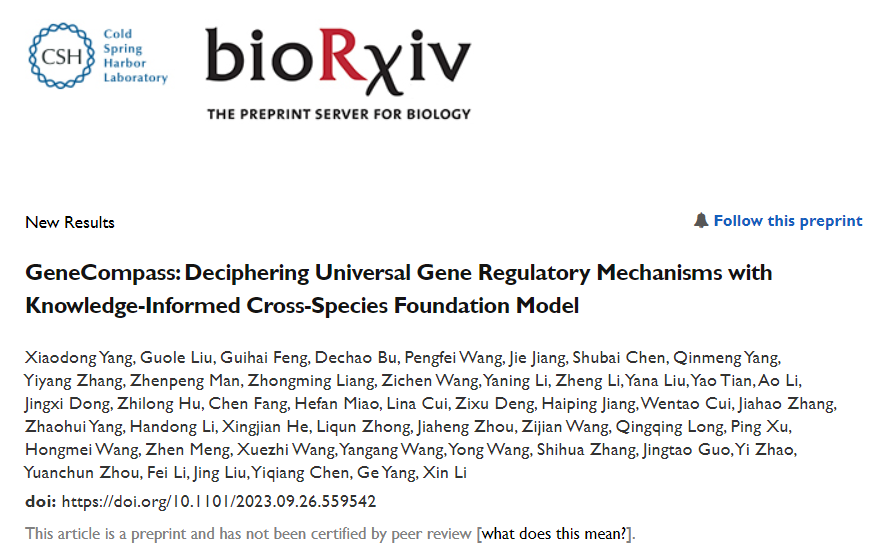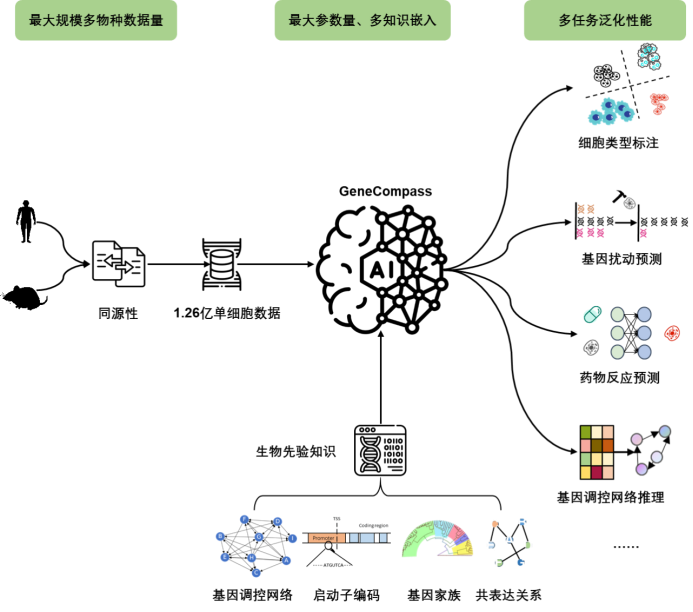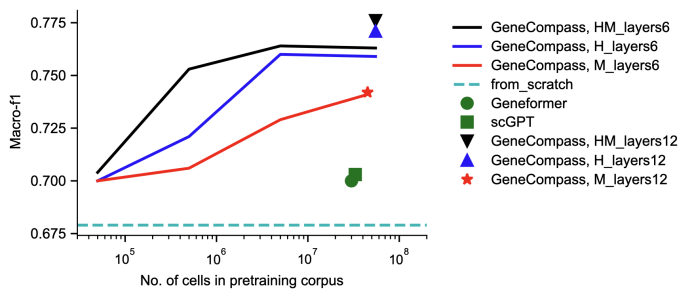 Technology peripherals
Technology peripherals
 AI
AI
 The research team of the Chinese Academy of Sciences released two important papers: the release of the first large-scale model of the basis of life across species, and the release of a new AI model for cell fate prediction
The research team of the Chinese Academy of Sciences released two important papers: the release of the first large-scale model of the basis of life across species, and the release of a new AI model for cell fate prediction
The research team of the Chinese Academy of Sciences released two important papers: the release of the first large-scale model of the basis of life across species, and the release of a new AI model for cell fate prediction

Author | Chinese Academy of Sciences Multidisciplinary Research Team
Editor | ScienceAI
Known as one of the three major scientific projects of mankind in the 20th century The genome project has kicked off an in-depth analysis of the mysteries of life. Due to the multi-dimensional and highly dynamic nature of life processes, it is difficult for traditional experimental research methods to systematically and accurately decipher the underlying common laws of the genetic code. It is urgent to use powerful computing technology to achieve representation modeling and knowledge discovery of genetic data.
Currently, artificial intelligence technology with large models as the core has triggered revolutions in fields such as computer vision and natural language understanding, demonstrating in-depth understanding of data and knowledge, and is expected to be applied in the field of life science research, systems To accurately decipher the underlying common laws of genetic codes
Recently, the "Xcompass Consortium" (Xcompass Consortium) composed of a multi-disciplinary interdisciplinary research team of the Chinese Academy of Sciences has made important breakthroughs in artificial intelligence empowering life science research. Successfully Constructed the world's first large-scale model of the basis of cross-species life - GeneCompass. This model integrates the transcriptome data of more than 126 million single cells of humans and mice, and integrates four types of prior knowledge including promoter sequences and gene co-expression relationships. The number of basic model parameters reaches 130 million, realizing the control of gene expression. Panoramic learning and understanding of regulatory laws simultaneously supports prediction of cell state changes and accurate analysis of various life processes, demonstrating the great potential of artificial intelligence in empowering life science research.
The study is titled "GeneCompass: Deciphering Universal Gene Regulatory Mechanisms with Knowledge-Informed Cross-Species Foundation Model" and was published on bioRxiv.

Paper link: https://www.biorxiv.org/content/10.1101/2023.09.26.559542v1
In addition, The team also simultaneously released a gene regulatory network generation model based on transfer learning, CellPolaris, which can accurately identify core factors for cell fate conversion and has the ability to simulate transcription factor perturbations.
The research is titled "CellPolaris: Decoding Cell Fate through Generalization Transfer Learning of Gene Regulatory Networks" and was published on bioRxiv.

GeneCompass: The first large-scale model of the basis of life across species

Individual mammals typically contain tens of thousands to tens of trillions of cells. Although all cells in an individual contain the same genetic sequence, the fate and function of each cell vary widely due to its unique spatiotemporal context. Such a sophisticated life process is controlled by a complex gene expression regulation system
In order to enhance the understanding of the essential laws of life and innovate the diagnosis and treatment of various major diseases, it is necessary to study the ubiquitous gene regulation mechanisms of life. Explore deeper. However, traditional research methods have low throughput and are limited to a single model organism, and cannot reveal complex gene regulatory mechanisms. In recent years, breakthroughs in single-cell omics technology have produced a large number of gene expression profile data of different types of cells. , providing a data basis for interpreting gene-gene interactions. At the same time, the development of deep learning, especially the emergence of large generative models, can comprehensively summarize the nonlinear regulation mechanism of massive data learning in different cell states, bringing unprecedented opportunities to life science research.
A large model of the basics of life across species, including 120 million cells and 130 million parametersCurrently, a single species has been obtained worldwide The scale of single-cell transcriptome data is only in the tens of millions, which is difficult to fully support the training of large models of basic life models used to analyze complex life processes.
The team collected open source single-cell transcriptome data from different species, and through pre-processing processes such as screening, cleaning, and normalization, established the largest known high-quality database, including more than 126 million cells in mice and humans. The training data set scCompass-126M adopts a deep learning architecture based on the Transformer self-attention mechanism, which can capture the long-term dynamic correlation between different genes in different cell backgrounds, and the model parameter size reaches 130 million. In order to achieve high-resolution characterization of life processes, GeneCompass dual-encodes gene numbers and expression levels for the first time, enabling effective and sensitive extraction of correlations between genes. This enables GeneCompass to provide more precise analysis of gene-gene interactions under a variety of specific conditions, such as cell types and perturbation states.
Embedding prior knowledge during pre-training can effectively improve model performance
The model effectively integrates promoter sequences, known gene regulatory networks, gene family information and gene co- Expressing the relationship between four kinds of biological prior knowledge, adding human annotation information encoding, improves the understanding of complex feature correlations between biological data. Through training and integrating data information and prior knowledge of different species, GeneCompass is expected to improve the efficiency and accuracy of traditional biological research and bring new entry points to complex life science problems that cannot yet be broken through.

Scale effect prompts model training to capture the conservative laws of biological evolution
The team found that models pre-trained on large-scale cross-species data can perform better on single-species subtasks It is consistent with the scaling law: larger-scale multi-species pre-training data can produce better pre-training representations and further improve the performance of downstream tasks. This finding shows that there are conserved gene regulation patterns between species, and that these patterns can be learned and understood by pre-trained models. At the same time, this also means that with the expansion of species and data, model performance is expected to continue to improve

Multi-task performance advantages show the powerful generalization ability of the basic large model
As the largest cross-species pre-trained basic life model with knowledge embedding to date, GeneCompass can realize multiple cross-species Transfer learning for downstream tasks, and achieving better performance than existing methods in cell type annotation, quantitative gene perturbation prediction, drug sensitivity analysis, etc. This fully demonstrates the strategic advantages of pre-training based on multi-species unlabeled big data and then using different sub-task data for model fine-tuning. It is expected to become a universal solution for analyzing and predicting various biological problems related to gene-cell characteristics.

Cell polarization: Transfer learning decodes gene regulatory networks and predicts cell fate changes
Using transfer learning to generate cells Specific gene regulatory network
The team also developed a set of gene regulatory network construction AI models based on generalized transfer learning, called CellPolaris. The model first sorts out hundreds of sets of transcriptome and chromatin accessibility data in matching cell scenarios to build a high-quality gene regulatory network, and then uses the generalized transfer learning model to generate more genes in cell scenarios using only transcriptome data. regulatory network. Then, using the generated high-confidence gene regulatory network, we developed a tool for identifying core transcription factors in cell fate transitions and a transcription factor perturbation simulation tool based on a probabilistic graphical model. This model can effectively identify the core factors of cell fate conversion and realize the simulation of transcription factor perturbation. It has important application value in the analysis of gene regulatory mechanisms and the discovery of disease-causing genes.
× [Biological Neuroscience Mathematics Physics Chemistry Materials]
The above is the detailed content of The research team of the Chinese Academy of Sciences released two important papers: the release of the first large-scale model of the basis of life across species, and the release of a new AI model for cell fate prediction. For more information, please follow other related articles on the PHP Chinese website!

Hot AI Tools

Undresser.AI Undress
AI-powered app for creating realistic nude photos

AI Clothes Remover
Online AI tool for removing clothes from photos.

Undress AI Tool
Undress images for free

Clothoff.io
AI clothes remover

AI Hentai Generator
Generate AI Hentai for free.

Hot Article

Hot Tools

Notepad++7.3.1
Easy-to-use and free code editor

SublimeText3 Chinese version
Chinese version, very easy to use

Zend Studio 13.0.1
Powerful PHP integrated development environment

Dreamweaver CS6
Visual web development tools

SublimeText3 Mac version
God-level code editing software (SublimeText3)

Hot Topics
 1378
1378
 52
52
 A Diffusion Model Tutorial Worth Your Time, from Purdue University
Apr 07, 2024 am 09:01 AM
A Diffusion Model Tutorial Worth Your Time, from Purdue University
Apr 07, 2024 am 09:01 AM
Diffusion can not only imitate better, but also "create". The diffusion model (DiffusionModel) is an image generation model. Compared with the well-known algorithms such as GAN and VAE in the field of AI, the diffusion model takes a different approach. Its main idea is a process of first adding noise to the image and then gradually denoising it. How to denoise and restore the original image is the core part of the algorithm. The final algorithm is able to generate an image from a random noisy image. In recent years, the phenomenal growth of generative AI has enabled many exciting applications in text-to-image generation, video generation, and more. The basic principle behind these generative tools is the concept of diffusion, a special sampling mechanism that overcomes the limitations of previous methods.
 Generate PPT with one click! Kimi: Let the 'PPT migrant workers' become popular first
Aug 01, 2024 pm 03:28 PM
Generate PPT with one click! Kimi: Let the 'PPT migrant workers' become popular first
Aug 01, 2024 pm 03:28 PM
Kimi: In just one sentence, in just ten seconds, a PPT will be ready. PPT is so annoying! To hold a meeting, you need to have a PPT; to write a weekly report, you need to have a PPT; to make an investment, you need to show a PPT; even when you accuse someone of cheating, you have to send a PPT. College is more like studying a PPT major. You watch PPT in class and do PPT after class. Perhaps, when Dennis Austin invented PPT 37 years ago, he did not expect that one day PPT would become so widespread. Talking about our hard experience of making PPT brings tears to our eyes. "It took three months to make a PPT of more than 20 pages, and I revised it dozens of times. I felt like vomiting when I saw the PPT." "At my peak, I did five PPTs a day, and even my breathing was PPT." If you have an impromptu meeting, you should do it
 All CVPR 2024 awards announced! Nearly 10,000 people attended the conference offline, and a Chinese researcher from Google won the best paper award
Jun 20, 2024 pm 05:43 PM
All CVPR 2024 awards announced! Nearly 10,000 people attended the conference offline, and a Chinese researcher from Google won the best paper award
Jun 20, 2024 pm 05:43 PM
In the early morning of June 20th, Beijing time, CVPR2024, the top international computer vision conference held in Seattle, officially announced the best paper and other awards. This year, a total of 10 papers won awards, including 2 best papers and 2 best student papers. In addition, there were 2 best paper nominations and 4 best student paper nominations. The top conference in the field of computer vision (CV) is CVPR, which attracts a large number of research institutions and universities every year. According to statistics, a total of 11,532 papers were submitted this year, and 2,719 were accepted, with an acceptance rate of 23.6%. According to Georgia Institute of Technology’s statistical analysis of CVPR2024 data, from the perspective of research topics, the largest number of papers is image and video synthesis and generation (Imageandvideosyn
 Five programming software for getting started with learning C language
Feb 19, 2024 pm 04:51 PM
Five programming software for getting started with learning C language
Feb 19, 2024 pm 04:51 PM
As a widely used programming language, C language is one of the basic languages that must be learned for those who want to engage in computer programming. However, for beginners, learning a new programming language can be difficult, especially due to the lack of relevant learning tools and teaching materials. In this article, I will introduce five programming software to help beginners get started with C language and help you get started quickly. The first programming software was Code::Blocks. Code::Blocks is a free, open source integrated development environment (IDE) for
 From bare metal to a large model with 70 billion parameters, here is a tutorial and ready-to-use scripts
Jul 24, 2024 pm 08:13 PM
From bare metal to a large model with 70 billion parameters, here is a tutorial and ready-to-use scripts
Jul 24, 2024 pm 08:13 PM
We know that LLM is trained on large-scale computer clusters using massive data. This site has introduced many methods and technologies used to assist and improve the LLM training process. Today, what we want to share is an article that goes deep into the underlying technology and introduces how to turn a bunch of "bare metals" without even an operating system into a computer cluster for training LLM. This article comes from Imbue, an AI startup that strives to achieve general intelligence by understanding how machines think. Of course, turning a bunch of "bare metal" without an operating system into a computer cluster for training LLM is not an easy process, full of exploration and trial and error, but Imbue finally successfully trained an LLM with 70 billion parameters. and in the process accumulate
 PyCharm Community Edition Installation Guide: Quickly master all the steps
Jan 27, 2024 am 09:10 AM
PyCharm Community Edition Installation Guide: Quickly master all the steps
Jan 27, 2024 am 09:10 AM
Quick Start with PyCharm Community Edition: Detailed Installation Tutorial Full Analysis Introduction: PyCharm is a powerful Python integrated development environment (IDE) that provides a comprehensive set of tools to help developers write Python code more efficiently. This article will introduce in detail how to install PyCharm Community Edition and provide specific code examples to help beginners get started quickly. Step 1: Download and install PyCharm Community Edition To use PyCharm, you first need to download it from its official website
 A must-read for technical beginners: Analysis of the difficulty levels of C language and Python
Mar 22, 2024 am 10:21 AM
A must-read for technical beginners: Analysis of the difficulty levels of C language and Python
Mar 22, 2024 am 10:21 AM
Title: A must-read for technical beginners: Difficulty analysis of C language and Python, requiring specific code examples In today's digital age, programming technology has become an increasingly important ability. Whether you want to work in fields such as software development, data analysis, artificial intelligence, or just learn programming out of interest, choosing a suitable programming language is the first step. Among many programming languages, C language and Python are two widely used programming languages, each with its own characteristics. This article will analyze the difficulty levels of C language and Python
 AI in use | AI created a life vlog of a girl living alone, which received tens of thousands of likes in 3 days
Aug 07, 2024 pm 10:53 PM
AI in use | AI created a life vlog of a girl living alone, which received tens of thousands of likes in 3 days
Aug 07, 2024 pm 10:53 PM
Editor of the Machine Power Report: Yang Wen The wave of artificial intelligence represented by large models and AIGC has been quietly changing the way we live and work, but most people still don’t know how to use it. Therefore, we have launched the "AI in Use" column to introduce in detail how to use AI through intuitive, interesting and concise artificial intelligence use cases and stimulate everyone's thinking. We also welcome readers to submit innovative, hands-on use cases. Video link: https://mp.weixin.qq.com/s/2hX_i7li3RqdE4u016yGhQ Recently, the life vlog of a girl living alone became popular on Xiaohongshu. An illustration-style animation, coupled with a few healing words, can be easily picked up in just a few days.



